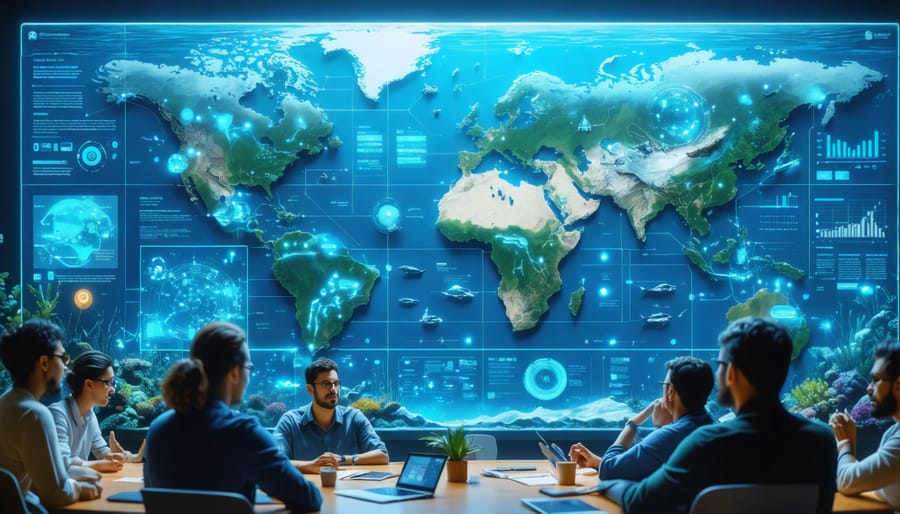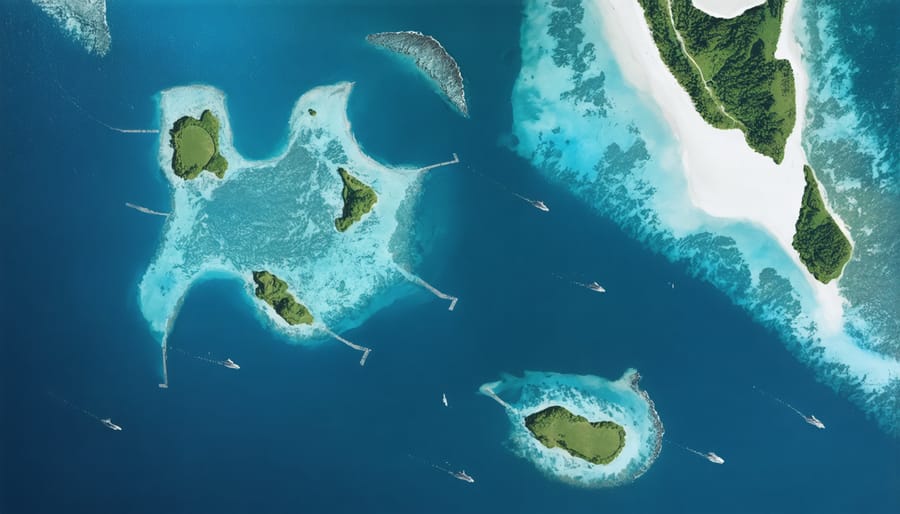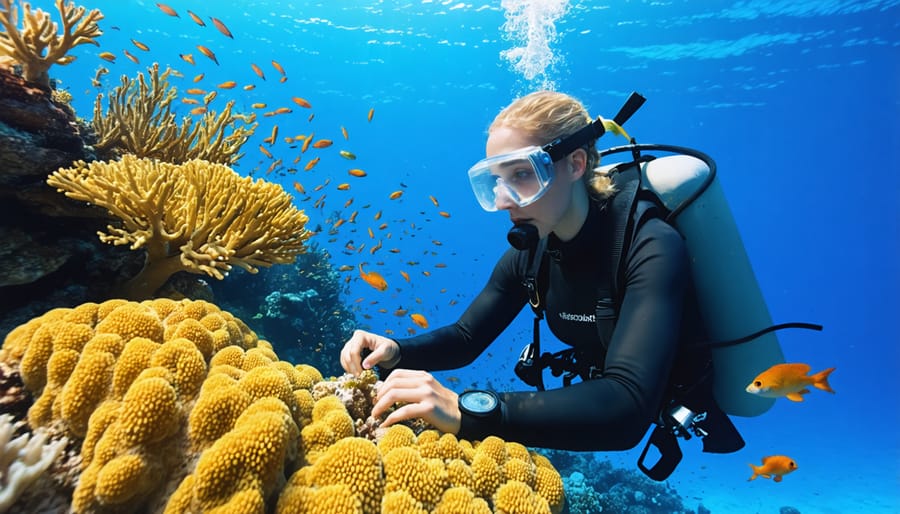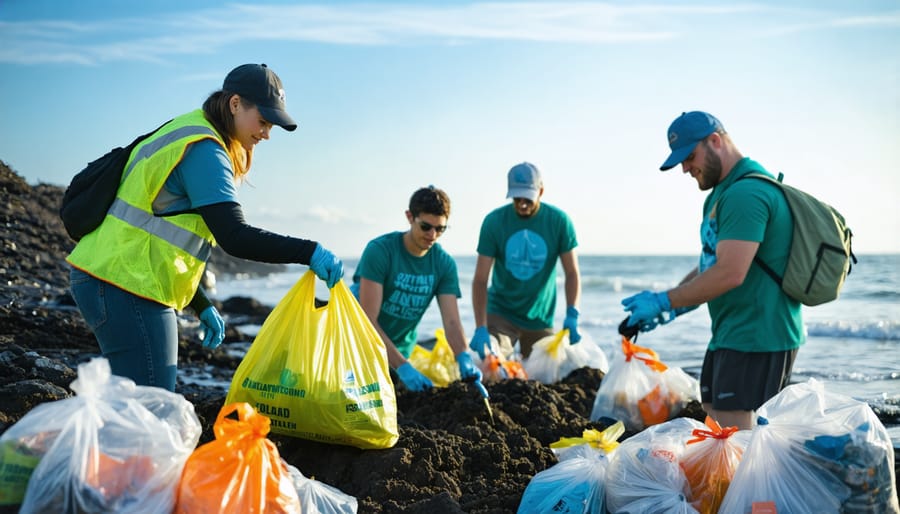
Coastal marine management stands at the intersection of science, policy, and community action, demanding an integrated approach to protect our ocean’s vital resources. Through carefully coordinated sustainable ocean development practices, coastal communities worldwide are pioneering innovative solutions to balance economic growth with marine ecosystem preservation.
From the vibrant coral reefs of the Indo-Pacific to the productive fisheries of the North Atlantic, our coastlines face unprecedented challenges from climate change, pollution, and resource exploitation. Yet, successful marine management initiatives demonstrate that local action, backed by scientific research and policy frameworks, can create resilient coastal ecosystems while supporting maritime economies.
Modern coastal management integrates traditional ecological knowledge with cutting-edge technology, employing satellite monitoring, artificial intelligence, and community-based conservation strategies. This adaptive approach ensures that marine protected areas, fishery regulations, and coastal development plans work in harmony to preserve biodiversity while sustaining coastal livelihoods.
The future of coastal marine management lies in collaborative governance models that embrace stakeholder participation, from indigenous communities to international organizations. By combining rigorous scientific monitoring with inclusive decision-making processes, we can build management systems that protect marine resources for generations to come.
Call to Action: Join local marine conservation efforts, participate in citizen science programs, or engage with coastal planning initiatives in your area to contribute to effective marine management solutions.
The Integration of Marine Spatial Planning
Mapping Marine Resources
Marine resource mapping involves sophisticated techniques combining satellite imagery, sonar technology, and hands-on field surveys to create detailed pictures of underwater ecosystems. Scientists and researchers use Geographic Information Systems (GIS) to layer multiple data sets, creating comprehensive maps that show everything from coral reef distributions to fish breeding grounds.
These maps typically categorize resources into three main groups: biological resources (like fish populations and seagrass beds), physical resources (such as sand deposits and mineral reserves), and cultural resources (including shipwrecks and traditional fishing grounds). Modern mapping techniques also incorporate real-time data from underwater sensors and autonomous vehicles, providing dynamic information about marine ecosystem health and resource availability.
Marine biologist Dr. Sarah Chen shares her experience: “When we map these resources, we’re not just creating charts – we’re telling the ocean’s story. Each data point helps us understand how marine life interacts with its environment and how we can better protect these precious ecosystems.”
Community involvement plays a crucial role in resource mapping. Local fishermen contribute traditional knowledge about fishing grounds and marine species behavior, while citizen scientists help collect data through mobile apps and organized surveys. This collaborative approach ensures that mapping efforts benefit from both scientific expertise and local ecological knowledge.
The resulting maps serve as essential tools for marine spatial planning, helping managers make informed decisions about conservation areas, sustainable fishing zones, and development restrictions.

Stakeholder Engagement
Successful coastal marine management relies heavily on meaningful engagement with diverse stakeholder groups. Local communities, who have generations of knowledge and direct connections to coastal areas, provide invaluable insights into traditional practices and environmental changes. Their involvement ensures that management strategies reflect local needs and cultural values while fostering a sense of ownership in conservation efforts.
Industry stakeholders, including fishing communities, tourism operators, and shipping companies, bring practical expertise and economic perspectives to the planning process. Their participation helps develop realistic management solutions that balance environmental protection with sustainable economic activities. Regular roundtable discussions and workshops facilitate dialogue between industry representatives and conservation experts, leading to more effective implementation of management policies.
Government agencies at local, regional, and national levels play crucial roles in coordinating stakeholder interests and enforcing regulations. Successful engagement often involves creating formal advisory committees that meet regularly to review progress and adjust strategies. Many coastal regions have established marine stewardship councils where stakeholders collaboratively develop management plans.
Public participation is encouraged through citizen science programs, community forums, and educational outreach initiatives. These activities not only gather valuable data but also build environmental awareness and support for conservation measures. Digital platforms and social media have made it easier to share information and gather feedback from various stakeholder groups, ensuring transparent and inclusive decision-making processes.
Sustainable Coastal Development

Economic Considerations
Coastal economies thrive on the delicate balance between resource utilization and conservation. Blue economy initiatives have emerged as a crucial framework for managing coastal resources while ensuring economic growth. These initiatives encompass various sectors, from tourism to aquaculture, promoting both prosperity and environmental stewardship.
Sustainable tourism represents a significant economic driver in coastal regions, generating revenue through eco-friendly activities like whale watching, snorkeling, and guided nature walks. When properly managed, these activities create jobs while minimizing environmental impact. Many coastal communities have successfully implemented visitor capacity limits and educational programs that enhance tourist experiences while protecting marine ecosystems.
The fishing industry, a traditional cornerstone of coastal economies, is evolving to embrace sustainability. Modern fishing quotas, seasonal restrictions, and improved monitoring systems help maintain fish populations while supporting local livelihoods. Advanced aquaculture practices are complementing traditional fishing, offering new opportunities for coastal communities.
Sustainable coastal industries also include renewable energy development, such as offshore wind farms and tidal energy projects. These initiatives create jobs while contributing to climate change mitigation. Port authorities are increasingly adopting green practices, implementing waste management systems, and investing in clean energy infrastructure.
The economic success of coastal regions increasingly depends on balancing immediate financial gains with long-term environmental sustainability. Communities that embrace this approach often experience enhanced economic resilience and improved quality of life for residents.
Environmental Impact Assessment
Environmental Impact Assessment (EIA) in coastal marine management involves systematic evaluation of potential effects from human activities on marine ecosystems. These assessments typically follow a structured approach, beginning with screening to determine the need for detailed study, followed by scoping to identify key environmental concerns.
Marine scientists employ various methods to gather baseline data, including underwater surveys, water quality testing, and biodiversity assessments. Modern technology like remote sensing and environmental DNA analysis has enhanced our ability to detect subtle ecosystem changes. These tools help create comprehensive environmental profiles that inform decision-making processes.
The assessment process examines both direct and indirect impacts. Direct impacts might include habitat destruction from coastal development or pollution from industrial discharge. Indirect effects often manifest as changes in food web dynamics or alterations to breeding patterns of marine species.
Mitigation strategies form a crucial component of EIAs. These might include establishing buffer zones around sensitive habitats, implementing seasonal restrictions on certain activities, or requiring specific technologies to reduce environmental harm. For instance, requiring silt curtains during dredging operations helps minimize sediment dispersion.
Monitoring programs track the effectiveness of these mitigation measures and allow for adaptive management. Regular reporting and stakeholder engagement ensure transparency and community involvement in the assessment process. This participatory approach has proven particularly effective in regions where traditional ecological knowledge complements scientific data.
Success stories from various coastal regions demonstrate how thorough EIAs have prevented environmental degradation while allowing sustainable development. These examples serve as models for future assessments and highlight the importance of balancing conservation with economic needs.
Conservation and Protection Measures
Marine Protected Areas
Marine Protected Areas (MPAs) serve as powerful tools in coastal marine management, offering sanctuaries where marine life can thrive and ecosystems can recover from human impacts. These protected zones range from strictly preserved areas to multiple-use regions that allow sustainable activities like regulated fishing or ecotourism.
Successful MPA design relies on several key factors: clear conservation objectives, appropriate size and location, connectivity between protected areas, and consideration of local socioeconomic needs. Scientists recommend establishing networks of MPAs rather than isolated reserves, as this approach better supports species migration patterns and genetic diversity.
Implementation requires careful stakeholder engagement, particularly with local communities and fishing industries. Experience shows that MPAs are most effective when local communities actively participate in their planning and management. For instance, the locally-managed marine areas (LMMAs) in the Pacific Islands have demonstrated remarkable success by combining traditional knowledge with modern conservation practices.
MPA management faces ongoing challenges, including enforcement in remote areas, securing sustainable funding, and adapting to climate change impacts. However, innovative solutions are emerging, such as satellite monitoring systems, community-based ranger programs, and public-private partnerships for funding.
Recent studies indicate that well-managed MPAs can increase fish biomass by up to 670% and help maintain coral reef health. They also provide economic benefits through sustainable tourism and enhanced fishing in adjacent areas, creating a compelling case for their expansion in coastal management strategies.

Species Protection Programs
Species protection programs form the backbone of coastal marine conservation efforts, combining scientific research, community engagement, and policy implementation to safeguard endangered marine species. These initiatives focus on protecting critical habitats, establishing breeding grounds, and monitoring population dynamics of vulnerable species.
Key programs include sea turtle conservation projects, which protect nesting beaches and involve local communities in monitoring activities. Marine biologist Dr. Sarah Chen shares, “We’ve seen remarkable success with our turtle monitoring program, where community volunteers help protect nesting sites and collect valuable data on population trends.”
Marine mammal protection initiatives focus on reducing vessel strikes and establishing protected corridors for migration routes. These programs often employ advanced tracking technologies and work with shipping companies to modify travel routes during peak migration seasons.
Coral reef protection programs combine habitat restoration with climate change resilience strategies. Scientists and volunteers work together to transplant healthy coral fragments and monitor reef health, while also implementing measures to reduce local stressors like pollution and overfishing.
Successful species protection requires collaboration between multiple stakeholders. For example, the Pacific Coast Salmon Recovery program brings together indigenous communities, scientists, and local governments to restore salmon populations through habitat improvement and sustainable fishing practices.
These programs often provide opportunities for public participation through citizen science initiatives, volunteer programs, and educational outreach, making marine conservation accessible to everyone interested in protecting our coastal ecosystems.
Community Involvement and Education

Volunteer Programs
Volunteer programs play a vital role in coastal marine management, offering citizens the opportunity to contribute directly to conservation efforts while gaining valuable hands-on experience. Many organizations coordinate beach cleanup initiatives, which not only remove harmful debris but also contribute to important data collection on marine pollution patterns.
Citizen science projects enable volunteers to participate in coral reef monitoring, seagrass surveys, and marine species counting. These programs often involve training sessions where participants learn scientific methodologies and data collection techniques. Popular activities include photographing and identifying marine species, monitoring water quality, and tracking sea turtle nesting patterns.
Several marine research centers and conservation organizations offer structured volunteer programs ranging from weekend commitments to long-term positions. These opportunities often include working alongside marine biologists and conservation experts, providing invaluable learning experiences for students and enthusiasts alike.
For those unable to commit to regular field work, virtual volunteer opportunities exist through online databases and mobile apps, where citizens can help classify marine species from photographs or transcribe historical marine data. These collaborative efforts between scientists and volunteers have become increasingly important in expanding our understanding of coastal ecosystems and implementing effective management strategies.
Educational Initiatives
Educational initiatives play a vital role in fostering coastal conservation awareness and promoting sustainable marine management practices. The Ocean Literacy Program, launched by marine educators and scientists, reaches thousands of students annually through interactive workshops and field experiences. These programs combine classroom learning with hands-on activities, allowing participants to understand marine ecosystems firsthand.
Coastal communities have implemented successful “Beach Ambassador” programs, where trained volunteers educate visitors about local marine life, proper waste disposal, and responsible beach behavior. Marine discovery centers along coastlines offer immersive learning experiences, featuring touch tanks, educational exhibits, and guided tours led by marine biologists.
Digital platforms and mobile applications have revolutionized marine education, enabling real-time tracking of marine species and monitoring of coastal health. Citizen science initiatives encourage public participation in data collection, creating a bridge between scientific research and community engagement.
Professional development workshops for teachers ensure that marine conservation education reaches future generations effectively. These programs provide educators with resources, curriculum materials, and methodologies to integrate marine science into their teaching plans, fostering environmental stewardship from an early age.
Future Challenges and Solutions
As coastal regions face increasing pressures from climate change and human activities, several critical challenges emerge that require innovative solutions and adaptive management strategies. Rising sea levels and more frequent extreme weather events pose significant threats to coastal infrastructure and ecosystems, while growing populations in coastal areas create additional strain on marine resources.
One of the most pressing challenges is balancing marine economic development with environmental protection. Communities must find ways to sustain their livelihoods while preserving fragile coastal ecosystems. Innovative approaches, such as eco-tourism certification programs and sustainable fishing practices, offer promising solutions that benefit both the environment and local economies.
Emerging technologies are revolutionizing how we monitor and protect coastal areas. Satellite monitoring systems, underwater drones, and AI-powered data analysis help track ecosystem changes, detect illegal fishing activities, and predict potential environmental threats. These tools, combined with traditional ecological knowledge, create more effective management strategies.
Community-based management programs are gaining traction as effective solutions to coastal challenges. These initiatives empower local communities to participate in decision-making processes and implement conservation measures. Success stories from various coastal regions demonstrate how involving stakeholders in management decisions leads to better compliance and more sustainable outcomes.
Looking ahead, coastal managers must prepare for challenges related to ocean acidification, plastic pollution, and habitat loss. Solutions include developing marine protected areas with climate-resilient designs, implementing stricter pollution controls, and restoring critical habitats like mangroves and seagrass beds.
The future of coastal marine management lies in adaptive, integrated approaches that combine scientific innovation with community engagement. By fostering collaboration between scientists, local communities, and policymakers, we can develop more resilient coastal management strategies that protect both marine ecosystems and human interests for generations to come.
Effective coastal marine management represents a critical intersection of science, policy, and community action. Throughout this article, we’ve explored how integrated approaches to marine conservation can protect our precious coastal ecosystems while supporting ocean-based economic solutions. The success of these management strategies depends on continued collaboration between scientists, policymakers, local communities, and stakeholders.
As we’ve seen, successful marine management requires a multi-faceted approach combining spatial planning, ecosystem-based management, and community engagement. The challenges facing our coastal environments are significant, but the solutions we’ve discussed demonstrate that positive change is possible through coordinated action and commitment.
You can make a difference by getting involved in local marine conservation initiatives, supporting sustainable fishing practices, or participating in citizen science programs. Many coastal communities offer volunteer opportunities for beach cleanups, wildlife monitoring, and educational outreach. Whether you’re a scientist, educator, or concerned citizen, your contribution matters.
The future of our coastal ecosystems depends on the actions we take today. By implementing comprehensive management strategies and fostering community involvement, we can ensure the preservation of marine biodiversity for generations to come. Together, we can build resilient coastal communities while protecting the delicate balance of our marine ecosystems.
jessica
Ava Singh is an environmental writer and marine sustainability advocate with a deep commitment to protecting the world's oceans and coastal communities. With a background in environmental policy and a passion for storytelling, Ava brings complex topics to life through clear, engaging content that educates and empowers readers. At the Marine Biodiversity & Sustainability Learning Center, Ava focuses on sharing impactful stories about community engagement, policy innovations, and conservation strategies. Her writing bridges the gap between science and the public, encouraging people to take part in preserving marine biodiversity. When she’s not writing, Ava collaborates with local initiatives to promote eco-conscious living and sustainable development, ensuring her work makes a difference both on the page and in the real world.
